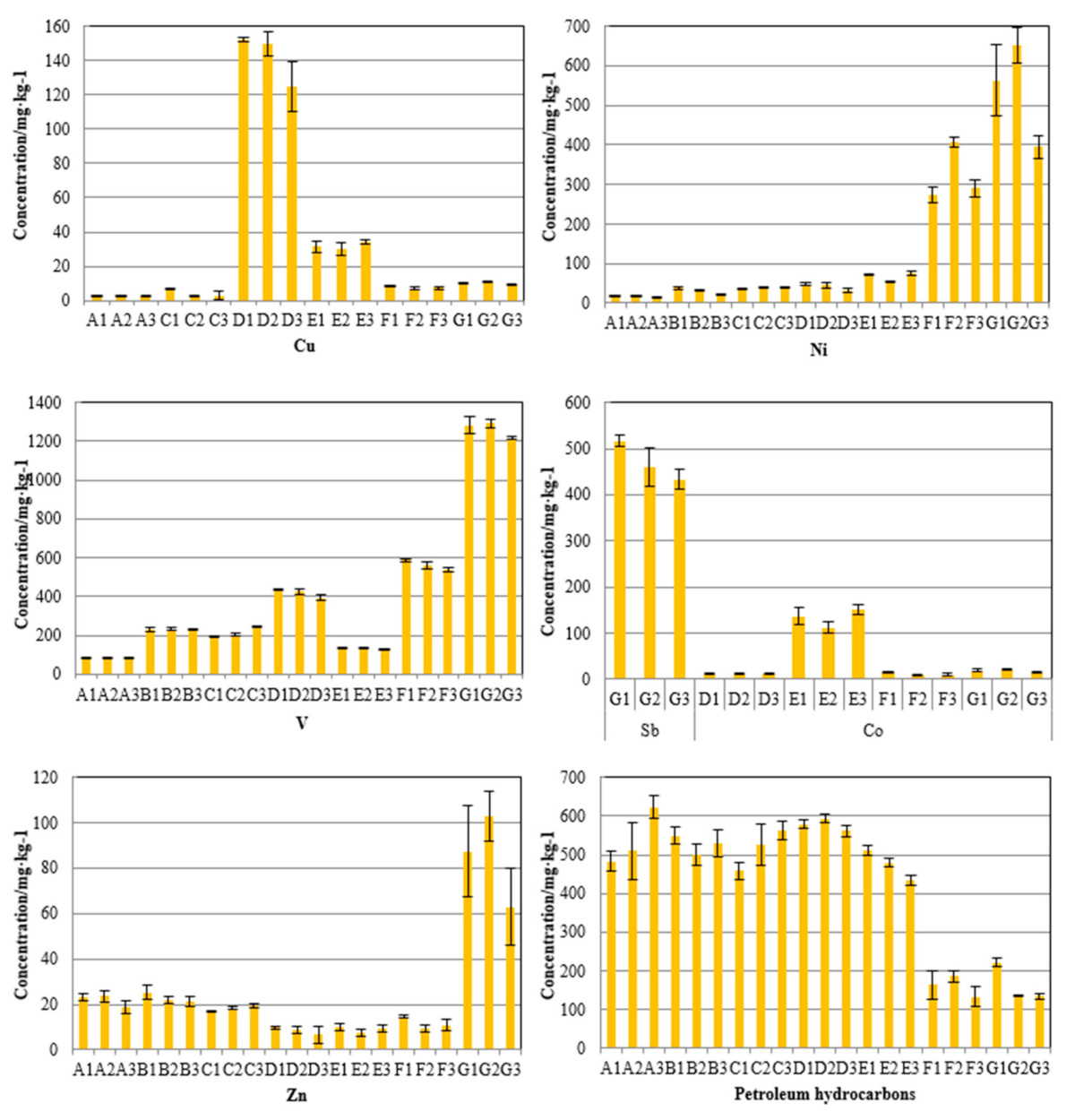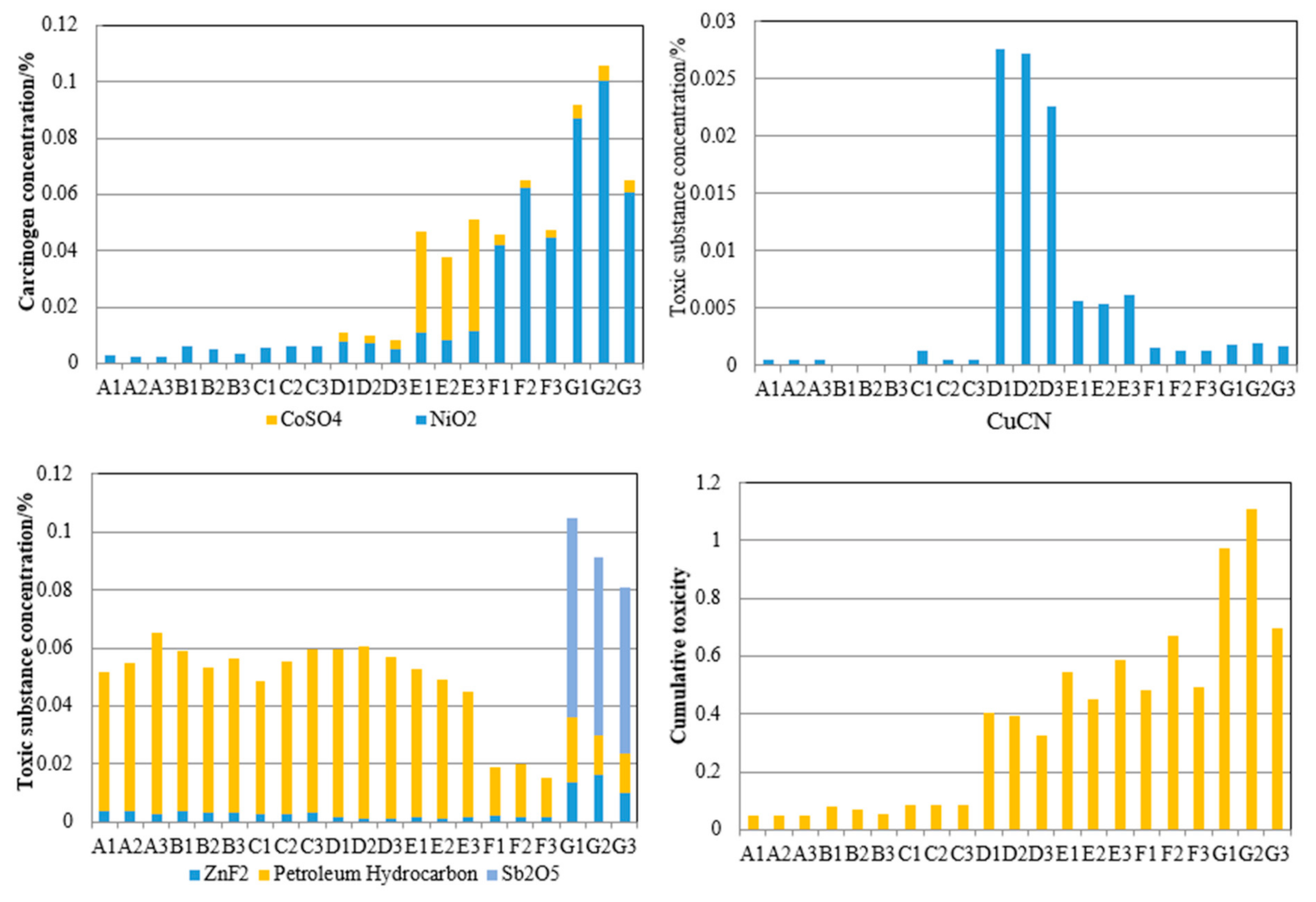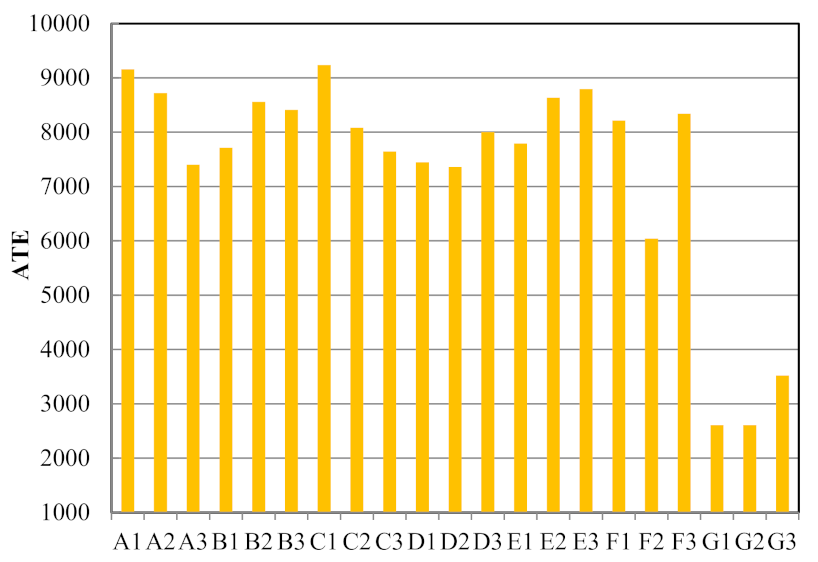Research on Hazardous Waste Removal Management: Identification of the Hazardous Characteristics of Fluid Catalytic Cracking Spent Catalysts
Abstract
:1. Introduction
2. Results and Discussion
2.1. Screening of Characteristic Pollutants of FCC Spent Catalysts
2.1.1. Analysis of the Hazardous Characteristics of FCC Spent Catalysts
2.1.2. Screening of Characteristic Organic Pollutants
2.1.3. Screening of Characteristic Heavy Metal Pollutants
2.2. Study on the Content of Toxic Substances in FCC Spent Catalysts
2.2.1. Heavy Metal Content in FCC Waste Catalysts in Different Units
2.2.2. Calculation of Toxic Substance Content
2.3. Study on the Toxicity of FCC Spent Catalysts
2.4. Acute Toxicity Study of FCC Spent Catalyst
3. Materials and Methods
3.1. Materials
3.2. Experimental Methods
3.2.1. Heavy Metal Test Methods
3.2.2. Organic Test Methods
3.2.3. Carbon Test Method
4. Conclusions
Author Contributions
Funding
Institutional Review Board Statement
Informed Consent Statement
Data Availability Statement
Conflicts of Interest
Sample Availability
References
- Akcil, A.; Vegliò, F.; Ferella, F.; Okudan, M.D.; Tuncuk, A. A review of metal recovery from spent petroleum catalysts and ash. Waste Manag. 2015, 45, 420–433. [Google Scholar] [CrossRef] [PubMed]
- Sadeghbeigi, R. FCC catalysts. In Fluid Catalytic Cracking Handbook, 3rd ed.; Elsevier: Waltham, MA, USA, 2012; pp. 87–116. [Google Scholar] [CrossRef]
- Cerqueira, H.S.; Caeiro, G.; Costa, L.; Ribeiro, F.R. Deactivation of FCC catalysts. J. Mol. Catal. A Chem. 2008, 292, 1–13. [Google Scholar] [CrossRef]
- Zheng, J.; Luo, Y.; Yu, H.; Liu, K. Industrial application of RFCC catalyst (CRM-200) containing mesoporous silica-alumina. Petroleum Process. Petrochem. 2015, 46, 39–43. [Google Scholar] [CrossRef]
- Wu, Y. Commercial application of novel heavy oil catalytic cracking catalyst. Jiangxi Chem. Ind. 2019, 15–17. [Google Scholar] [CrossRef]
- Nazarova, G.; Ivashkina, E.; Ivanchina, E.; Oreshina, A.; Dolganova, I.; Pasyukova, M. Modeling of the catalytic cracking: Catalyst deactivation by coke and heavy metals. Fuel Proces. Technol. 2020, 200, 1–12. [Google Scholar] [CrossRef]
- Rodriguez, E.; Bernal, S.; Provis, J.; Gehman, J.; Monzo, J. Geopolymers based on spent catalyst residue from a fluid catalytic cracking (FCC) process. Fuel 2013, 109, 493–502. [Google Scholar] [CrossRef]
- Zhao, X.M. Recovery and utilization of waste FCC catalysts. Pet. Refin. Eng. 2017, 47, 51–55. Available online: https://kns.cnki.net/KCMS/detail/detail.aspx?dbcode=CJFD&filename=LYSZ201704022 (accessed on 7 March 2021).
- US EPA Archive Document. Federal Register/Vol.63, No.151/Thursday, August 6, 1998/Rules and Regulation.42162.
- Azevedo Daniele, M.F.; Silva, J.A.S.; Servulo, E.F.C.; Frescura, V.L.A.; Dognini, J.; Oliveira, F.J.S. Recovery of lanthanides from hydrocarbon cracking spent catalyst through chemical and biotechnological strategies. J. Environ. Sci. Health Part. A Toxic/Hazard. Subst. Environ. Eng. 2019, 54, 1–9. [Google Scholar] [CrossRef]
- Zhou, Y.J.; Schulz, S.; Lindoy, L.F.; Du, H.; Zheng, S.; Wenzel, M.; Weigand, J.J. Separation and recovery of rare earths by in situ selective electrochemical oxidation and extraction from spent fluid catalytic cracking (FCC) catalysts. Hydrometallurgy 2020, 194, 1–11. [Google Scholar] [CrossRef]
- Lu, G.J.; Lu, X.Y.; Liu, P. Recovery of rare earth elements from spent fluid catalytic cracking catalyst using hydrogen peroxide as a reductant. Miner. Eng. 2020, 145, 1–8. [Google Scholar] [CrossRef]
- Zheng, S.Q.; Liu, S.C.; Zhang, P.Q.; Yang, C.; Wang, T. Adsorption of Cu2+, Zn2+, and Ni2+ Ions onto the Adsorbent Prepared from Fluid Catalytic Cracking Spent Catalyst Fines and Diatomite. Chem. Ind. J. Chem. Chem. Eng. 2019, 68, 201–208. [Google Scholar] [CrossRef]
- Su, B.C.; Li, S.; Liu, N.; Wang, X.; Meng, X. Removal of sulfur compounds from LPG by heteropoly acid-modified spent FCC catalyst. Appl. Organometal. Chem. 2019, 33. [Google Scholar] [CrossRef]
- Antiohos, S.K.; Chauliara, E.; Tsimas, S. Re-use of spent catalyst from oil cracking refineries as supplementary cementing material. China Particuol. Sci. Technol. Part 2006, 4, 73–76. [Google Scholar] [CrossRef]
- Payá, J.; Monzó, J.; Borrachero, M.V.; Velázquez, S. Cement Equivalence Factor Evaluations for Fluid Catalytic Cracking Catalyst Residue. Cem. Concr. Compos. 2013, 39, 12–17. [Google Scholar] [CrossRef]
- Borrachero Rosado, M.V.; Monzó Balbuena, J.M.; Payá Bernabeu, J.J.; Vunda, C.; Velázquez, R.S.; Soriano, M.L. Spent FCC catalyst for improving early strength of Portland cement. ACI Mater. J. 2014, 111, 59–66. [Google Scholar]
- Velázquez, S.; Monzó, J.; Borrachero, M.V.; Soriano, L.; Payá, J. Evaluation of the pozzolanic activity of spent FCC catalyst/fly ash mixtures in Portland cement pastes. Thermochim. Acta 2016, 632, 29–36. [Google Scholar] [CrossRef]
- Souza, N.L.A.; Tkach, I.; Morgado, E.; Krambrock, K. Vanadium poisoning of FCC catalysts: A quantitative analysis of impregnated and real equilibrium catalysts. Appl. Catal. A Gen. 2018, 560, 206–214. [Google Scholar] [CrossRef]
- Stöcker, M.; Tangstad, E.; Aas, N.; Myrstad, T. Quantitative determination of Ni and V in FCC catalysts monitored by ESR spectroscopy. Catal. Lett. 2000, 69, 223–229. [Google Scholar] [CrossRef]
- Xu, M.; Liu, X.; Madon, R.J. Pathways for Y zeolite destruction: The role of sodium and vanadium. J. Catal. 2002, 260, 237–246. [Google Scholar] [CrossRef]
- Busca, G.; Riani, P.; Garbarino, G.; Ziemacki, G.; Gambino, L.; Montanari, E.; Millini, R. The state of nickel in spent Fluid Catalytic Cracking catalysts. Appl. Catal. A Gen. 2014, 486, 176–186. [Google Scholar] [CrossRef]
- Garbarino, G.; Riani, P.; Infantes-Molina, A.; Rodríguez-Castellón, E.; Busca, G. On the detectability limits of nickel species on NiO/γ-Al2O3 catalytic materials. Appl. Catal. A Gen. 2016, 525, 180–189. [Google Scholar] [CrossRef]
- Bin, D.H.; Zhu, X.M.; Fu, H.H.; Hao, Y.Q.; Huang, Q.F.; Yang, Y.; Yang, Z.L. The pollution characteristics and risk of main metal pollutants in spent FCC catalysts in China. J. Environ. Eng. Technol. 2019, 9, 453–459. [Google Scholar] [CrossRef]
- Liu, T.; Qiu, Z.; Yang, J.; Mei, X.; Cao, L.; Zhang, W. Morphological, composition analysis, and environmental risks assessment of spent FCC catalysts. Inorg. Chem. Ind. 2016, 48, 71–74. [Google Scholar] [CrossRef]
- Sun, H.; Li, S. Migration and distribution of heavy metals nickel and vanadium during inferior crude oil processing. Chem. Bioeng. 2018, 35, 2203–2210. [Google Scholar] [CrossRef]
- Yan, X.; Ran, Z.; Xiang, X. Research on the Source and Migration Pathways of the Metals in Refinery Solid Waste. Environ. Protect. Oil Gas. Fields 2018, 109, 34–37. [Google Scholar] [CrossRef]
- Liu, T.; Liu, H.; Deng, L. Preparation of Foamed Ceramics by Waste FCC Catalyst. Bull. Chin. Ceram. Soc. 2020, 39, 568–574. [Google Scholar] [CrossRef]
- Xue, Y.; Wei, X.; Zhao, H.; Wang, T.; Xiao, Y. Interaction of spent FCC catalyst and asphalt binder: Rheological properties, emission of VOCs and immobilization of metals. J. Clean. Prod. 2020, 259, 1–8. [Google Scholar] [CrossRef]





| Set | A | B | C | D | E | F | G |
|---|---|---|---|---|---|---|---|
| C/wt.% | 0.028 | 0.028 | 0.016 | 0.032 | 0.020 | 0.018 | 0.050 |
| Set | Fe | Ni | V | Na | Ca | Cu |
|---|---|---|---|---|---|---|
| A | 0.98 | 0.14 | 0.21 | 0.95 | 0.97 | 0.06 |
| B | 1.85 | 0.16 | 0.17 | 1.04 | 1.21 | 0.17 |
| C | 0.75 | 0.19 | 0.96 | 0.22 | 0.42 | 0.07 |
| D | 1.20 | 0.7 | 0.99 | 0.13 | 0.23 | 0.08 |
| E | 1.36 | 0.69 | 0.57 | 0.71 | 1.38 | 0.10 |
| F | 2.90 | 2.72 | 1.80 | 0.42 | 2.77 | ND |
| G | 5.51 | 4.24 | 2.27 | 0.95 | 3.95 | 0.02 |
| Main/Auxiliary | Main Ingredients |
|---|---|
| FCC catalyst | Al2O3, SiO2, Na2O, SO42−, Fe2O3, etc. |
| CO combustion denitrifier | Al2O3, Fe2O3, Pd, Pt, and other precious metals and rare earth oxides |
| CO combustion aid | Support Al2O3 or SiO2–Al2O3, active components platinum, palladium, and other heavy metals, Na2O |
| Sulfur transfer agent | Al2O3, MgO, La2O3, V2O5, etc. |
| Octane additive | SiO2, Al2O3, trace rare earth elements, trace Na2O, Fe, SO42−, and Cl− |
| Pollutants | Corresponding Compound | Toxicity Category | Conversion Factor |
|---|---|---|---|
| Co | CoSO4 | Carcinogen | 155/59 |
| Ni | NiO2 | Carcinogen | 91/59 |
| Cu | CuCN | Highly toxic substance | 89.5/64 |
| Zn | ZnF2 | Toxic Chemical | 103/65 |
| Sb | Sb2O5 | Toxic Chemical | 323.5/243.5 |
| Petroleum Hydrocarbon | Petroleum Hydrocarbon | Toxic Chemical | 1 |
| Toxic Substances | CoSO4 | Pb3(PO4)2 | CuCN | ZnF2 2) | V2O5 | Sb2O5 2) | NiO2 2) | Petroleum Hydrocarbon 2) |
|---|---|---|---|---|---|---|---|---|
| Oral LD50 1) | 389 | 540 | 500 | 5 | 5 | 5 | 5 | 5 |
| Set | Type and Proportion of Feedstocks | Information of Feedstocks | Types of Additives | Capacity (10 K t/year) | Regenerator Temperature (°C) | |||
|---|---|---|---|---|---|---|---|---|
| Density (20 °C) (kg/m3) | S (%) | Initial Distillation Point (°C) | Final Distillation Point (°C) | |||||
| A | Hydrogenated diesel 100% | 910 | 0.02 | 170 | 360 | No addition | 69 | 680 |
| B | Hydrogenated straight-run wax oil 55%, hydrodeasphalted oil 35%, purchased wax oil 10% | 909 | 0.24 | 219 | 737 | CO combustion denitrification agent, sulfur transfer agent, octane booster | 230 | 690 |
| C | Hydrogenated wax oil 100% | 895 | 0.41 | 211 | 556 | CO combustion promoter, sulfur transfer agent | 290 | 680 |
| D | Straight-run wax oil 50%, hydrogenated wax oil 32%, catalytic feedstock oil 14%, naphtha 3%, etc. | 917 | 1.44 | 221 | 599 | CO combustion denitrifier, CO combustion promoter, octane booster | 69 | 680–700 |
| E | Hydrogenated wax oil 100% | 899 | 0.06 | 284 | 508 | CO combustion denitration agent, sulfur transfer agent | 65 | 680 |
| F | Hydrogenated wax oil 51%, hydrogenated residue 30%, hydrogenated diesel 13%, 3% vacuum gas oil, etc. | 955 | 0.19 | 218 | 566 | CO combustion aid | 260 | 680 |
| G | Wax oil 35%, hydrogenated heavy oil (including hydrogenated residue about 40%) 40%, hydrogenated diesel 25% | 921 | 0.53 | 243 | 574 | CO combustion aid | 120 | 695 |
Publisher’s Note: MDPI stays neutral with regard to jurisdictional claims in published maps and institutional affiliations. |
© 2021 by the authors. Licensee MDPI, Basel, Switzerland. This article is an open access article distributed under the terms and conditions of the Creative Commons Attribution (CC BY) license (https://creativecommons.org/licenses/by/4.0/).
Share and Cite
Fu, H.; Chen, Y.; Liu, T.; Zhu, X.; Yang, Y.; Song, H. Research on Hazardous Waste Removal Management: Identification of the Hazardous Characteristics of Fluid Catalytic Cracking Spent Catalysts. Molecules 2021, 26, 2289. https://doi.org/10.3390/molecules26082289
Fu H, Chen Y, Liu T, Zhu X, Yang Y, Song H. Research on Hazardous Waste Removal Management: Identification of the Hazardous Characteristics of Fluid Catalytic Cracking Spent Catalysts. Molecules. 2021; 26(8):2289. https://doi.org/10.3390/molecules26082289
Chicago/Turabian StyleFu, Haihui, Yan Chen, Tingting Liu, Xuemei Zhu, Yufei Yang, and Haitao Song. 2021. "Research on Hazardous Waste Removal Management: Identification of the Hazardous Characteristics of Fluid Catalytic Cracking Spent Catalysts" Molecules 26, no. 8: 2289. https://doi.org/10.3390/molecules26082289
APA StyleFu, H., Chen, Y., Liu, T., Zhu, X., Yang, Y., & Song, H. (2021). Research on Hazardous Waste Removal Management: Identification of the Hazardous Characteristics of Fluid Catalytic Cracking Spent Catalysts. Molecules, 26(8), 2289. https://doi.org/10.3390/molecules26082289





